A Half Day Trip From Aswan to Amazing Abu Simbel
In this destination guide, we make a half day trip from Aswan to Abu Simbel and show you how you can visit this famous Egyptian temple.
Aswan to Abu Simbel
The last sight which I would visit in and around Aswan was also by far the most famous one: Abu Simbel.
The massive rock-hewn temples of Abu Simbel rank among the best-known of all ancient Egyptian sights and are a true highlight of any visit to Egypt.
Located some 280 kilometres south-east across the desert from Aswan, Abu Simbel is however not easy to reach.
Although there is a small town with some hotels next to Abu Simbel and some people do stay overnight here so they can see the sound and light show in the evening or visit the temples away from the crowds in the early morning, most tourists opt for a half-day trip from Aswan.
That was exactly what my plan was: Driving south to Abu Simbel in the wee hours of morning, visit the temples, and return back to Aswan in time for the afternoon departure of my Nile river cruise.
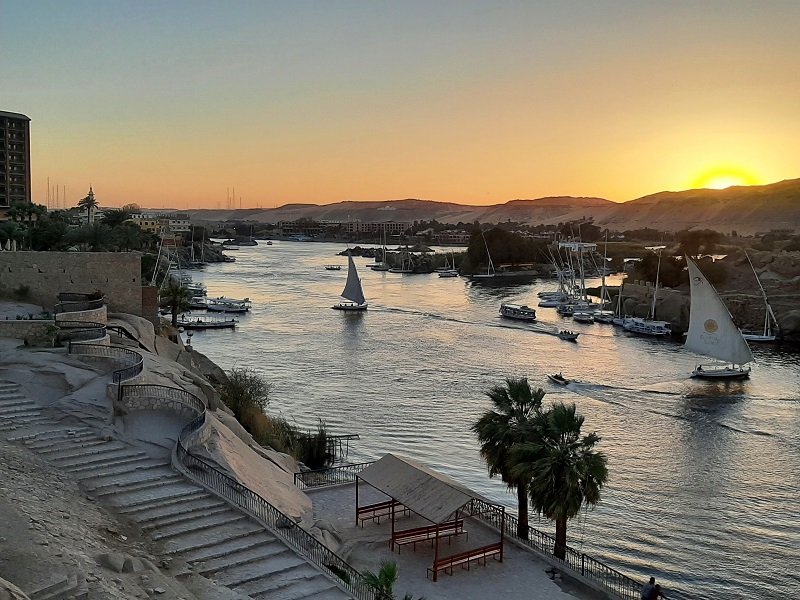
Arranging my trip
I had arranged my half day trip to Abu Simbel through the same outfit where I had booked my Nile cruise: Luxor & Aswan Travel Agency, a tour agency which I can wholeheartedly recommend.
Together with my excellent guide Mohammed Badawy, with whom I also visited some of the other ancient Egyptian archaeological sites in and around Aswan the day before, I would head out to Abu Simbel in the early morning.
This certainly wasn’t cheap as I got quoted $170 for it with all costs included after some haggling.
Even though this was quite a lot of money for me as an independent traveller, I have to say that in the end the experience was certainly worth it and I was glad I went for it.
Travelling in my private SUV with my own guide and driver certainly was a rather luxurious way to visit the temples and more importantly, it added a lot of flexibility to my programme which turned out to be invaluable (I’ll explain this in more detail further down).
Transport options to Abu Simbel
In any case, you should note that a trip to Abu Simbel won’t come cheap no matter how you arrange it.
Indeed, it can get even much more expensive if you opt to fly there instead of drive.
Egyptair offers return flights from Aswan to Abu Simbel Airport during the main tourist season, with enough time between arrival and departure to see the temples.
These Aswan to Abu Simbel flights connect with Cairo-Aswan flights, which makes it even theoretically possible to visit the temples as a long day trip from Cairo by plane.
The cheapest option to visit Abu Simbel is by going on an organised bus tour, for which I’ve seen prices quoted between $50 and $70 per person excluding the entrance fee.
A good middle ground between your own private trip with driver and guide and slugging it out with 40 or so other people in an organised bus tour is by organising a private transfer between Aswan and Abu Simbel.
However, do note that you will likely have to arrange your private transfer through a travel agency as drivers need a special permit to drive to Abu Simbel and pass the checkpoints – and most taxi drivers are unlikely to have this.
If you add the costs of the entrance fee and a guide (which really is recommended if you want to understand the unique symbolism of the temples) the cost savings are negligible if you compare transport-only options with a full organised trip.
Long drive
Having my private driver and guide gave me one huge advantage: Full flexibility.
Usually, the morning departure time of a half day trip to Abu Simbel is 4.30am – which given the three-and-a-half hour drive isn’t much of a surprise.
However, the day before our departure my guide Mohammed suggested that we could leave even a bit earlier than this if I wanted to be sure that we would be at Abu Simbel before the crowds.
Mohammed had yet another brilliant trick up his sleeve as instead of taking the main route over the Aswan dam which all other buses and private vehicles use, we would take a detour towards the north.
Although this roundabout route takes longer, it would allow us to cross the Nile immediately on a bridge just to the north of Aswan instead of having to wait for the police checkpoints on the dam to open in the early morning.
This way, we would already be on the left bank of the Nile and thus among the first vehicles at the second police checkpoint on the main Aswan – Abu Simbel road, way ahead of all the tourist buses.
At precisely 4am we set off from Aswan – and our plan indeed worked like a charm.
Being quite tired, I slept for most of the way, only to wake up to a fabulous sunrise over the empty desert.


Abu Simbel history
Before I will describe my experience visiting Abu Simbel, let’s first take a short look at its history.
Abu Simbel exists out of two rock-hewn temples which were constructed in the 13th Century BC under the reign of Pharaoh Ramses II (whose name is also spelled as Ramesses II).
Ramses II, who is nicknamed Ramses the Great, is one of the most famous of all Egyptian Pharaohs who reigned during the era of the New Kingdom, one of the golden ages in the history of Ancient Egypt.
Together with some other archaeological sites in the historical region of Nubia such as Philae, the temples at Abu Simbel are inscribed on the UNESCO World Heritage list.
Originally, the Abu Simbel temples were carved out of a cliff on the banks of the River Nile.
When they fell in disuse, the temples were eventually swallowed up by the desert sand and remained buried for many centuries until Swiss geographer Johann Ludwig Burckhardt rediscovered Abu Simbel in 1813.
In 1817, Italian Egyptologist Giovanni Belzoni was finally able to dig out the temples and gain entry to them.
Temple relocation
When the Aswan High Dam and the giant artificial reservoir of Lake Nasser were constructed in the 1960s, the rising water threatened to flood Abu Simbel.
To save Abu Simbel, it was decided to dismantle and relocate the temples in their entirety to higher ground.
Although Abu Simbel’s current location overlooking the windswept waters of Lake Nasser is not historically authentic, everything else you see of the temples is, as the relocation was supervised by a team of archaeologists and UNESCO experts.
In fact, everything you see is in the exact same position as when Belzoni first explored the temples.
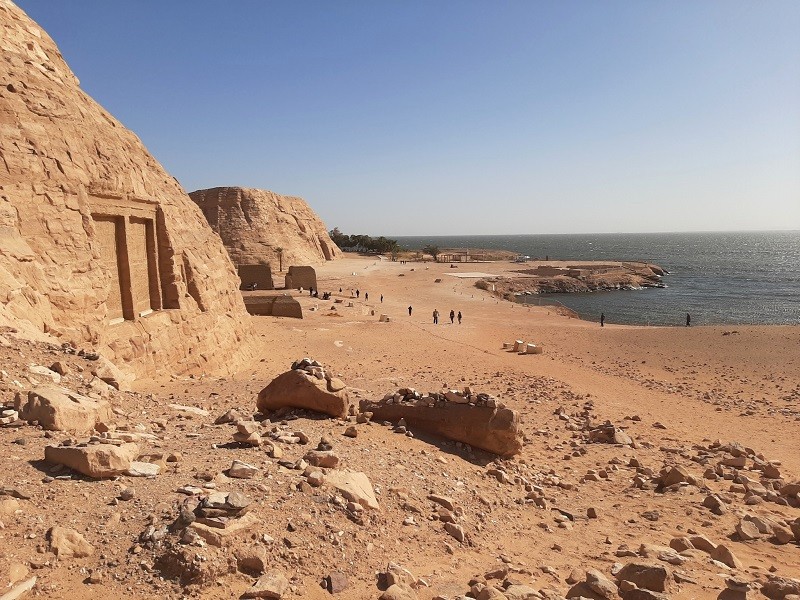


Temple façade
From the main parking lot and ticket office, a sand path along Lake Nasser takes you to the temples.
The moment you first set your eyes on Abu Simbel is surely one of the highlights of any trip to Egypt.
With its four large statues of Ramses the Great guarding the entrance, the main temple of Abu Simbel (also called the great temple) is absolutely impressive to look at.
The second statue from the left is said to have collapsed in an earthquake shortly after the construction of the temple.
When Abu Simbel was relocated in the 1960s, it was decided to leave these collapsed pieces in the exact same position as they were first discovered by Belzoni.
All four statues depict Ramses the Great wearing the famous double crown of Lower and Upper Egypt.
The smaller statues sitting next to Ramses depict his wife in the shape of the goddess Hathor while the statues in between his legs depict their children.
On the huge pedestal blocks, you can see images of the enslaved enemies of Ramses the Great, with his Asiatic adversaries visible on the right hand side and his Nubian enemies on the left hand side.

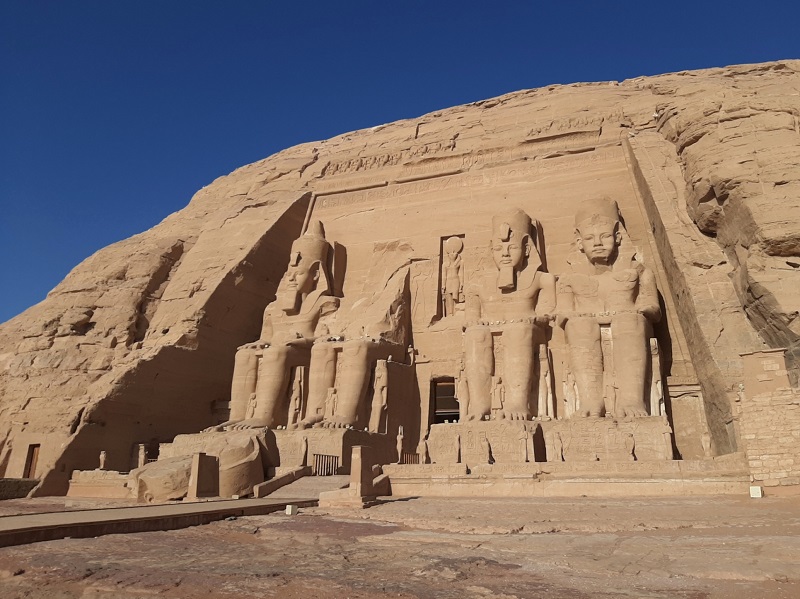


Entering the temple
Mohammed’s plan to leave early and to take an alternative route worked like a charm.
When we entered the main temple of Abu Simbel at 8am there was nobody else around, although the low tourist numbers in Egypt during the COVID pandemic played a role in this as well.
I just can’t describe how amazing it is to explore a temple like Abu Simbel without other tourists around.
When I entered the empty temple I felt like one of the early explorers and archaeologists like Burckhardt, Belzoni and Carter – it was definitely such a travel moment when you get goose bumps all over your skin.
The first room of the main temple of Abu Simbel is the hypostyle hall which is flanked on each side by four massive pillars.
In front of each pillar stands a statue of Ramses the Great in the shape of Osiris, the ancient Egyptian god of the underworld.
The ceiling decoration represents the goddess Nekhbet, the protector of Upper Egypt, spreading her wings.



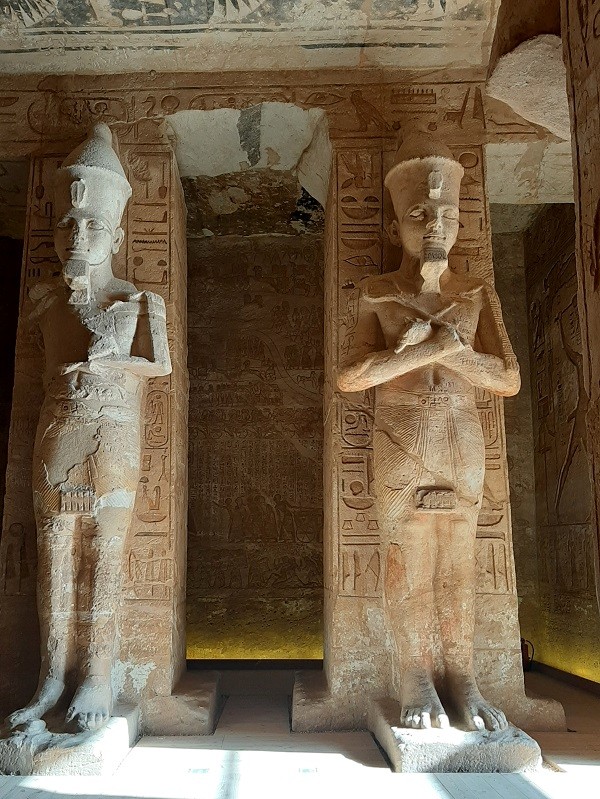




Heroics of Ramses the Great
The scenes depicted in the hypostyle hall are amazing and with a good guide at your side they really come alive.
Most of the paintings, carvings and hieroglyphs detail the heroics of Pharaoh Ramses the Great, such as the famous relief of him slaying his Hittite enemies in the Battle of Kadesh in what is now modern-day Syria.
One particularly striking stone carving shows Ramses the Great fighting in his war chariot during the Battle of Kadesh, which is said to be one of the largest battles between chariots ever fought.
If you look carefully enough, you can see that there are two horses , two arms and two bows – almost like Ramses has been duplicated and a mirror image of him has been created.
This actually depicts the moment in which Ramses the Great was ambushed during the war and asked the god Amun-Ra for help, who supported him with thousands of extra soldiers.
What you basically see is no-one else than Amun-Ra standing besides Ramses the Great in the chariot.
According to ancient Egyptian religion, nobody but the Pharaoh and the high priests were allowed to see the representation of the gods, so only Ramses the Great actually noticed that Amun-Ra was fighting besides him.
This is why the ancient Egyptian artists portrayed this scene by creating a double image of Ramses in his war chariot and by placing an image of the feathered crown of Amun-Ra right above Ramses the Great’s own crown.
Another beautiful relief shows Ramses in his war chariot being flanked by his pet lion chasing some of his Nubian enemies.
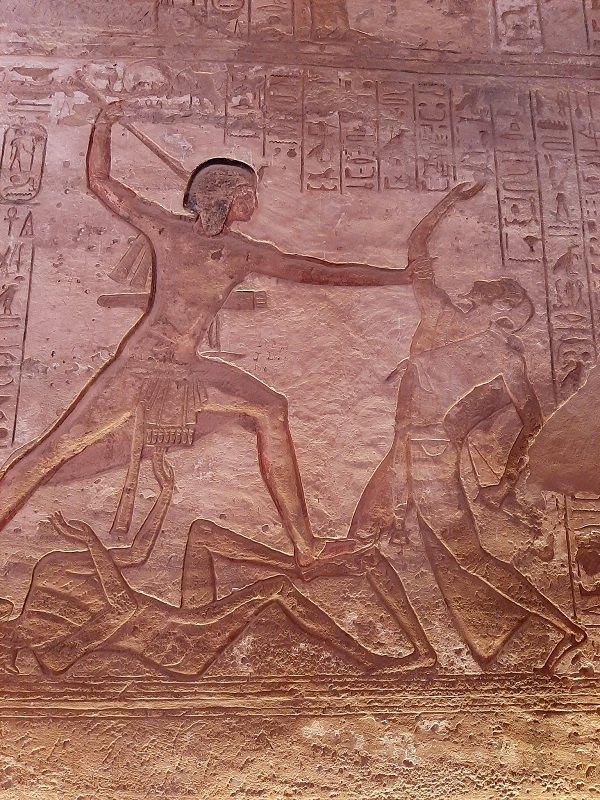




Storage rooms
Towards the side of the hypostyle hall you can find some long, rectangular storage rooms.
In ancient times, these rooms were the domain of the priests, who stored food and other goods such as oils and candles here which were needed to make an offer to the gods.
The images on the walls of these side rooms depict such offering scenes.
You can for example see Pharaoh Ramses the Great on his knees showing different types of offerings to the gods.
Another beautiful relief shows Ramses the Great during the coronation ritual.
He is depicted standing between the sun god Ra, clearly recognisable by his falcon head and the sun disk above him, and the wisdom god Thoth with his ibis beak.





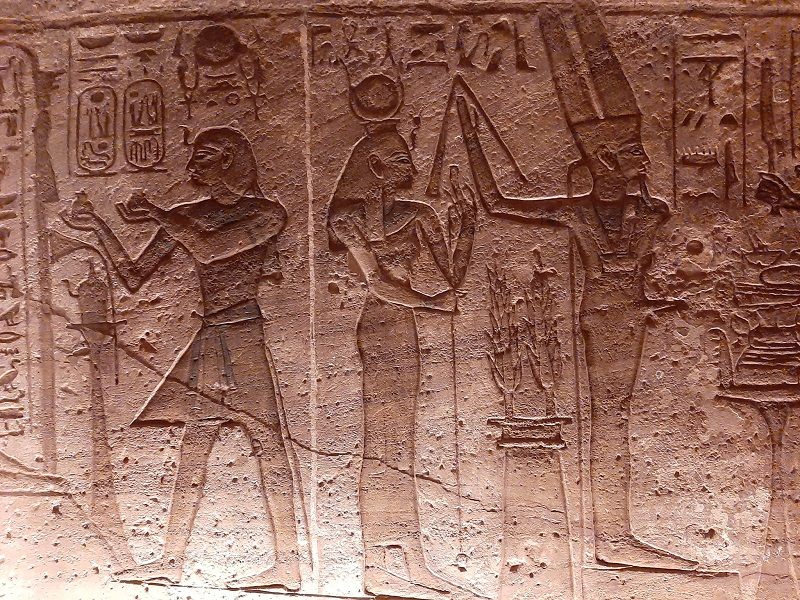
Second hall
Right behind the hypostyle hall is the second hall of the temple, which has four massive pillars in its centre.
Abu Simbel has the same generic lay-out as most other ancient Egyptian temples, with rooms decreasing in size the further you head away from the entrance.
The highlight here is a giant relief depicting the sacred barge of Amun-Ra being carried by the council of the priests, with Ramses the Great standing in front of the sacred boat burning incense.
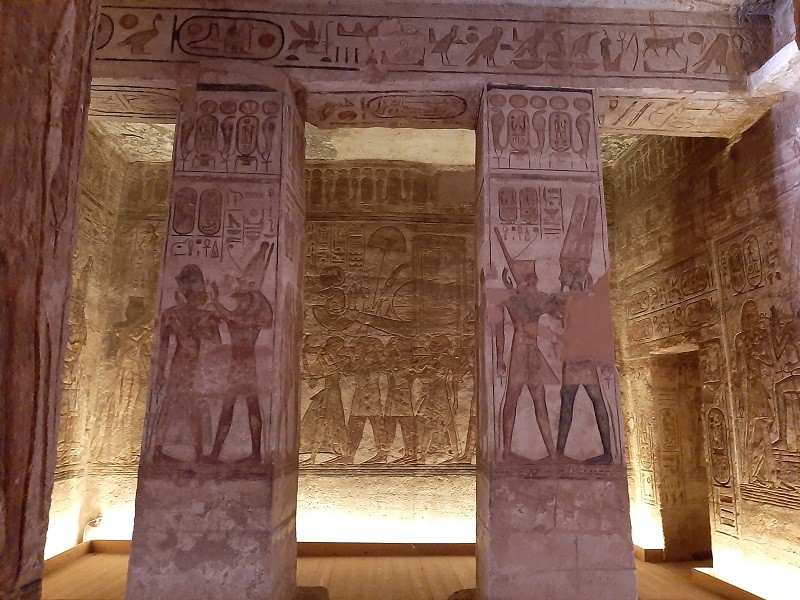
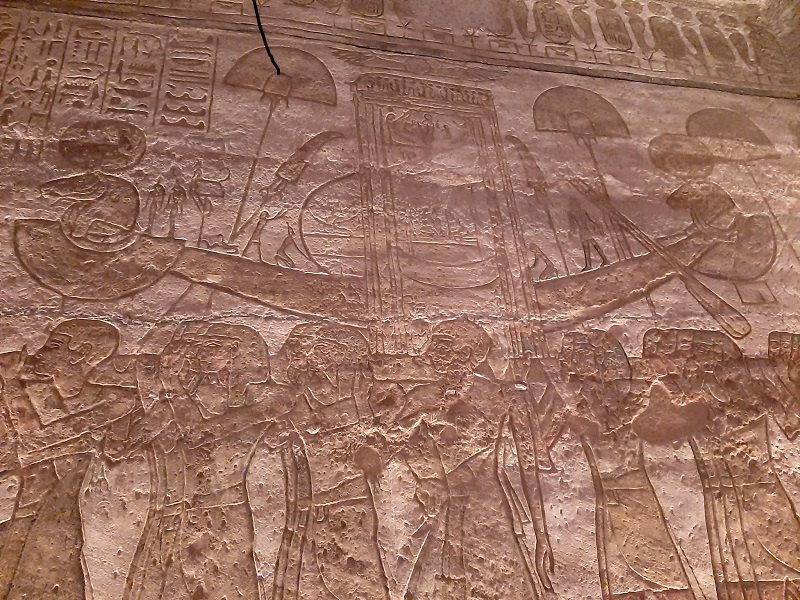
Sanctuary
A small vestibule links the second pillar hall with the sanctuary, the most important part of the temple and the exclusive domain of the pharaoh and the high priest.
At the heart of the sanctuary is a sculpture of four seated figures which has been cut out directly from the rock.
These figures are Ra-Horakhty, Amun, Ptah and Ramses the Great himself.
The brilliance behind ancient Egyptian architecture and science is clearly on show here, as the great temple of Abu Simbel was positioned in such a way that each year on 21st February and 21st October the sunlight would penetrate through the rooms and illuminate the sanctuary.
These days were not randomly chosen, as they are believed to be Ramses the Great’s birthday and his coronation day.
In another stunning feat of planning and craftsmanship, the statue of Ptah on the left side is never illuminated while the other thee sculptures are.
Again, that’s not a coincidence as Ptah was the god of the realm of the dead and therefore always remained in complete darkness.

Small temple
Besides the main temple, there is also a second, smaller temple at Abu Simbel located just 100 metres away.
The small temple is also called the temple of Hathor and Nefertari.
Hathor is the mother goddess of both the sky god Horus and sun god Ra, and thus is also some kind of symbolic mother figure of the pharaoh as the earthly representation of the gods.
Nefertari, whose name means ‘beautiful companion’, was the first wife of Ramses the Great.
Although a bit more understated compared to the great temple of Abu Simbel, I loved how beautiful and stylish the façade of the small temple was cut out of the rock.
The statues you see in front of the temple represent Ramses the Great and Nefertari.

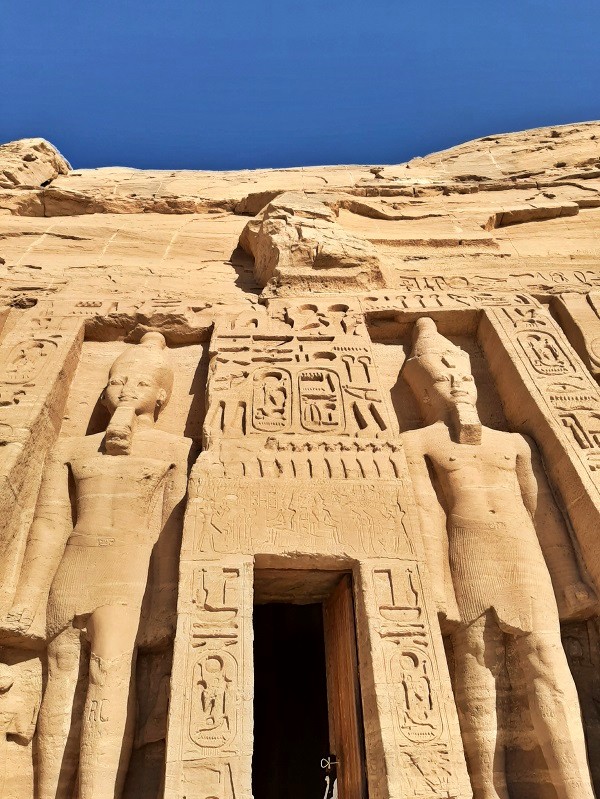
Inside the small temple
The temple of Hathor and Nefertari is basically a simplified, much smaller version of the great temple of Abu Simbel.
The hypostyle hall of the small temple features six pillars, each of them having the face of the goddess Hathor.


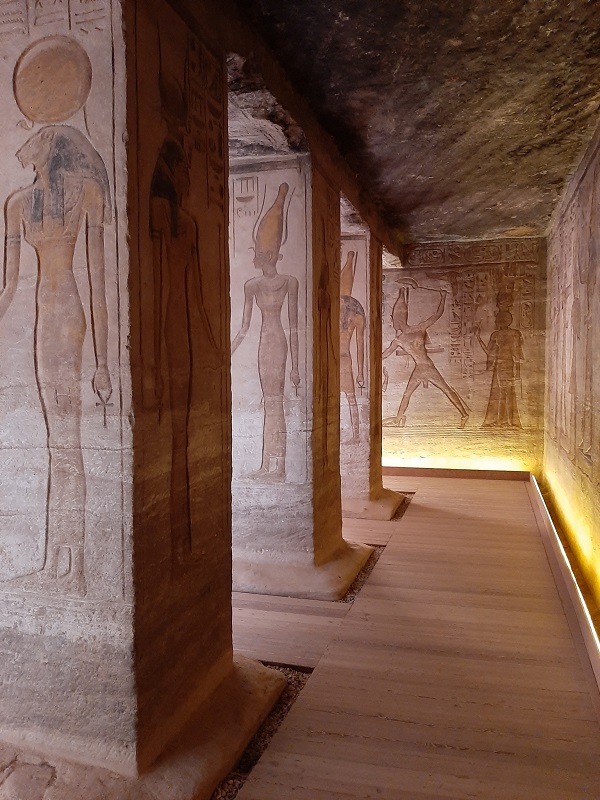


Small temple reliefs
The small temple has some wonderful reliefs as well, most of them showing Ramses the Great and his wife Nefertari in the company of some Egyptian gods.
One striking relief shows the coronation ritual in which the gods Set and Horus bless Pharaoh Ramses the Great, who is wearing the double crown of both Lower and Upper Egypt.
Another relief shows Queen Nefertari standing in a similar pose while being blessed by the goddesses Hathor and Isis in her coronation ritual.

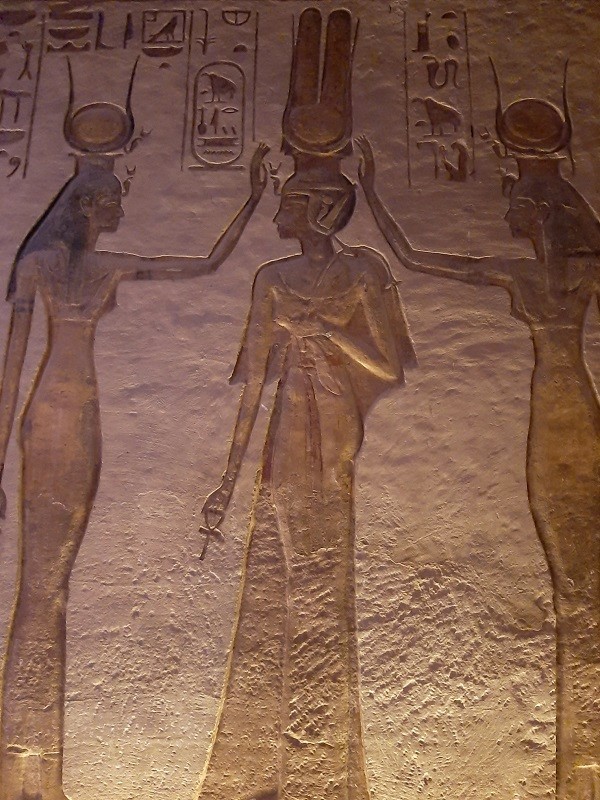

Sanctuary
From the hypostyle hall there are three open doorways which lead to a vestibule room from where you can access the sanctuary of the small temple.
In the niche carved out of the rock once stood a statue of Hathor in the shape of a cow while protecting Ramses the Great.
Unfortunately, both statues were defaced by the early Christians because they saw it as pagan worshipping.

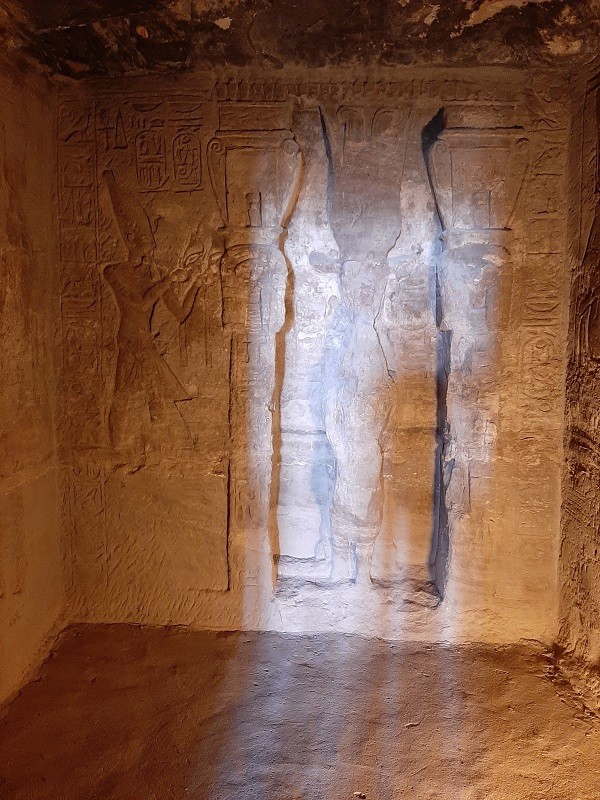
Arrival of the crowds
Before we walked back towards the car park, I took a couple of more minutes to walk around both temples on my own and to snap some more pictures.
Our timing was absolutely flawless as when I was finished, a few hundred tourists had just arrived by bus and descended down on the path towards the temples.
I can’t repeat enough how great it was to be able to explore the Abu Simbel temples in complete solitude.
Besides it obviously being much better for picture-taking, it also allows you to have a better grasp of the lay-out, design and reliefs of the temples as you won’t have dozens of other people constantly obscuring the view.

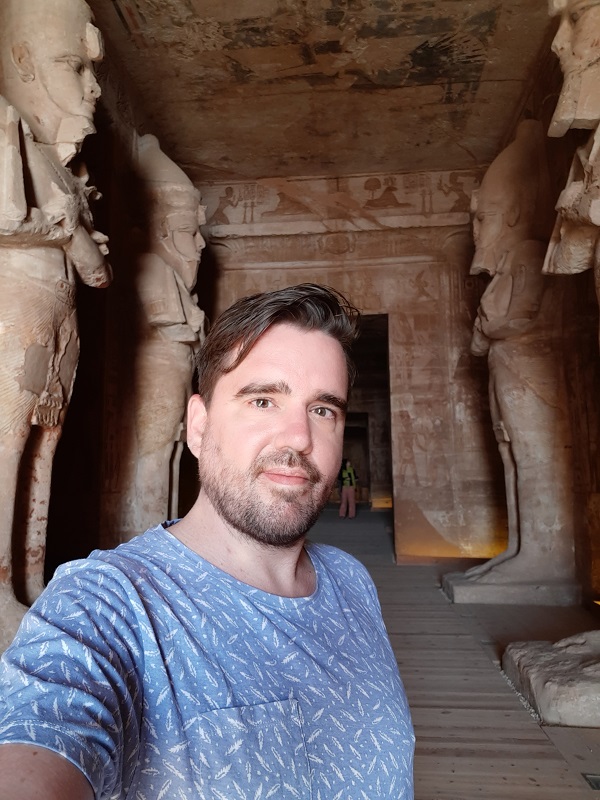
The long ride back to Aswan
Having visited both temples at Abu Simbel, it was time to start the long drive back to Aswan.
Just outside of the town of Abu Simbel, we did however first make a stop at a falafel stand as Mohammed had graciously offered to buy me what he thinks is some of the tastiest falafel in the Aswan area.
Indeed, both the falafel and the fresh bread in which it was wrapped were delicious.
Although the drive was again rather long, it went by faster than I thought this time around as I could finally admire the scenery from the window it being light outside.
Even though the scenery is just a flat and endless desert landscape, with only the occasional outcrop, checkpoint or settlement adding a bit of diversity, it was still good fun to stare outside the window.
We arrived back in Aswan with time to spare before lunch and the departure of my Nile river cruise.
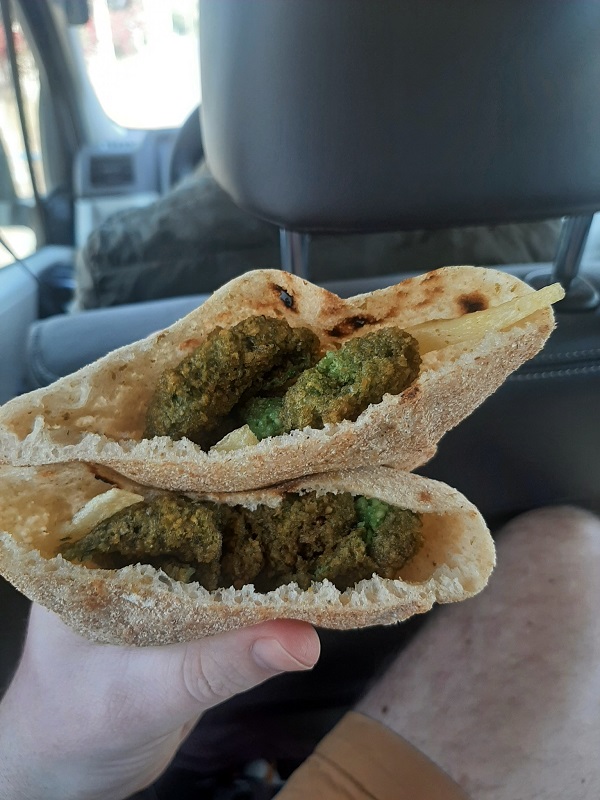





Conclusion
My half day trip from Aswan to Abu Simbel was an absolutely fantastic experience.
Even though the organised half-day trip with private transport and guide was rather expensive, I’m so happy I visited Abu Simbel this way as it allowed for full flexibility.
Thanks to the constructive thinking of my excellent guide Mohammed, we arrived way before all other tourists at Abu Simbel, allowing us to explore the magnificent temples in all quietness away from the crowds.
Abu Simbel is an amazing sight and the visually stunning temples will without doubt be one of the true highlights of your Egypt trip.
The Abu Simbel temples certainly rank among the top sights I’ve seen in Egypt and even though a half day trip won’t come cheap no matter how you plan it, it really is an unmissable sight and you would regret it not having gone the extra mile to get there from Aswan.
Acknowledgements
This article was written with the help and support of my Aswan guide, Mohammed Badawy.
If you need a professional guide in Aswan or Abu Simbel, I can highly recommend Mohammed’s services as he is not only extremely courteous and hospitable, but also a great source of knowledge about everything related to ancient Egypt being a professional archaeologist.
Mohammed can be contacted by e-mail (mohammed_badawy95 *at* yahoo.com) or by phone or Whatsapp on the number +201005448691).
Trip report index
This article is part of the ‘Walk Like an Egyptian: A Grand Tour of Egypt‘ trip report, which consists of the following chapters:
1. Red-Eye Ramblings of a Late Night Flight to Cairo
2. A Visit to the Pyramids of Giza by Camel
3. Review: Sofitel Nile El Gezirah, Zamalek, Cairo
4. Exploring the Medieval Old Town and Islamic History of Cairo
5. Visiting the Museum of Egyptian Antiquities in Cairo
6. Mar Girgis: The Churches of Christian Old Cairo
7. Review: Ernst Watania Sleeping Train Cairo to Aswan
8. The Ancient Quarry of Aswan and the Unfinished Obelisk
9. A Boat Ride From Aswan to the Temple of Isis at Philae
10. A Visit to the Aswan High Dam and Lake Nasser
11. A Visit to the Nubian Village on Aswan’s Elephantine Island
12. Aswan Guide: A Visit to Egypt’s Most Stunningly Located City
13. A Half Day Trip From Aswan to Amazing Abu Simbel (current chapter)
14. Nile River Cruise Guide: All Info for Your Egypt Boat Trip
15. Review: M/S Princess Sarah Nile River Cruise Ship
16. Nile Cruise: Sailing From Aswan to Kom Ombo
17. A Visit to the Ancient Crocodile Temple of Kom Ombo
18. A Visit to the Temple of Horus at Edfu
19. Nile Cruise: Sailing From Edfu to Luxor
20. Luxor, Egypt: Visiting the Sights of Ancient Thebes
21. A Visit to Luxor’s Giant Temple Complex of Karnak
22. Visitor Guide to Wonderful Luxor Temple
23. Valley of the Kings: A Visit to Luxor’s Ancient Necropolis
24. The Temple of Hatshepsut: A Visit to a Unique Mortuary Temple
25. Review: Sofitel Winter Palace Hotel, Luxor, Egypt
26. Review: Daytime Train Luxor to Cairo, Egypt
27. Review: Steigenberger Hotel El Tahrir, Cairo
28. A Visit to the Pyramid of Djoser and the Saqqara Necropolis
29. A Visit to the Dahshur Pyramid Complex
30. Memphis: Exploring the Old Capital of Ancient Egypt
31. From Cairo to Alexandria by Train: My Travel Experience
32. Review: Paradise Inn Le Metropole Hotel, Alexandria, Egypt
33. Alexandria: A Visit to Egypt’s Historic Mediterranean Port City
34. Egypt: Impressions and Reflections After My Two Week Trip
35. Epilogue: Safety and How to Deal With Street Hassle in Egypt

